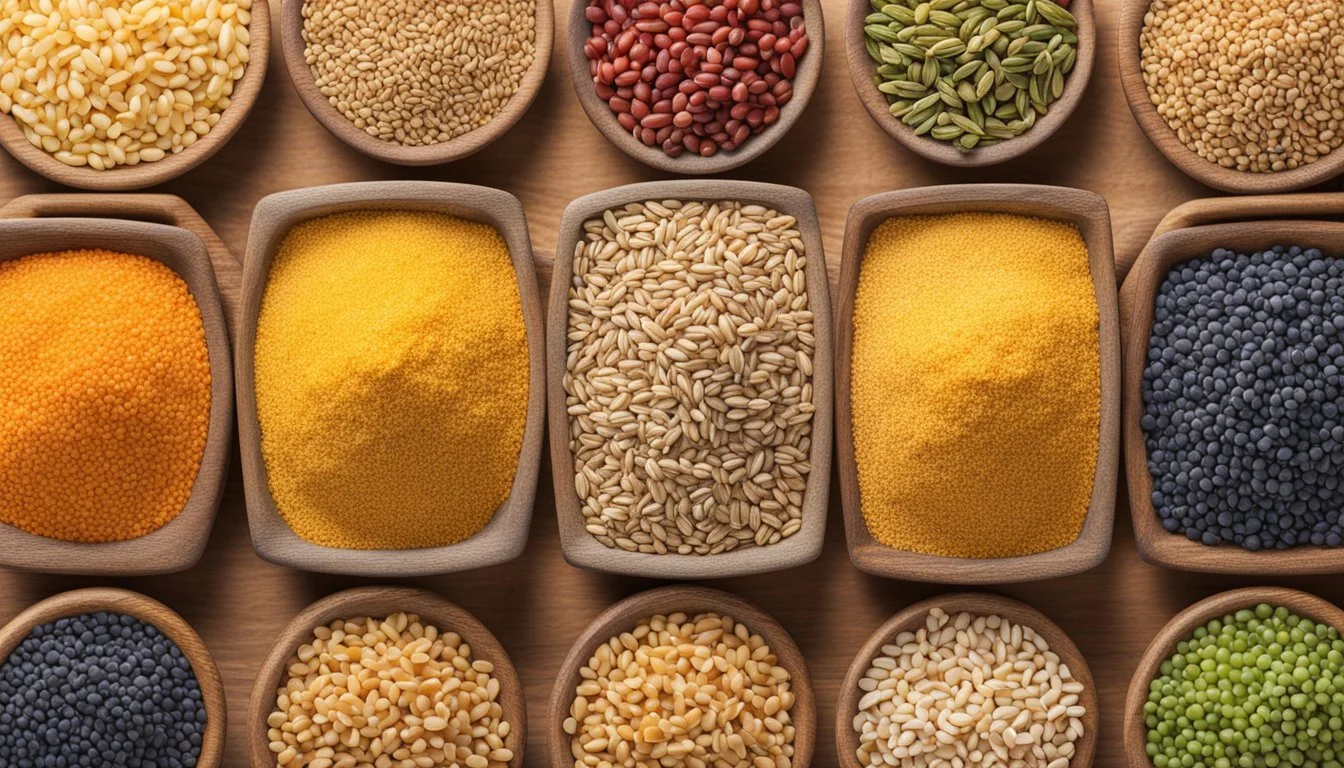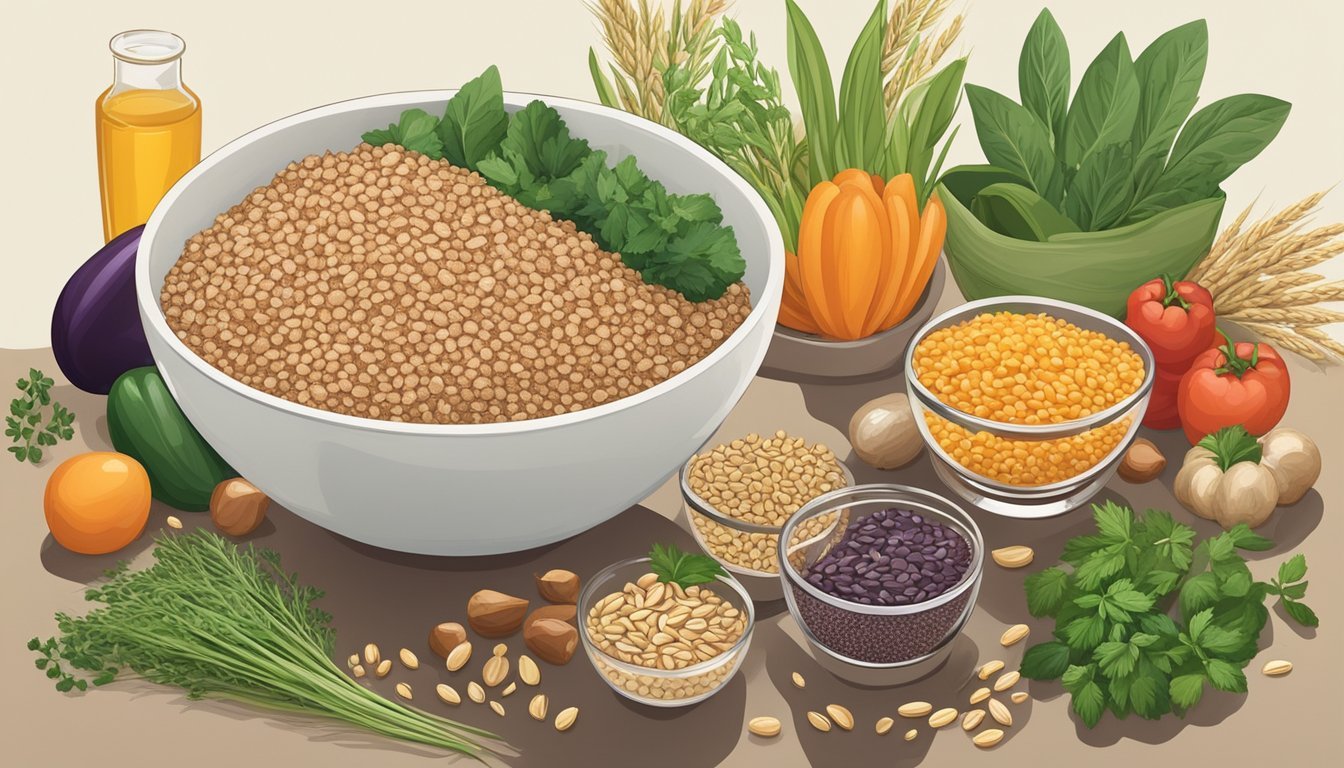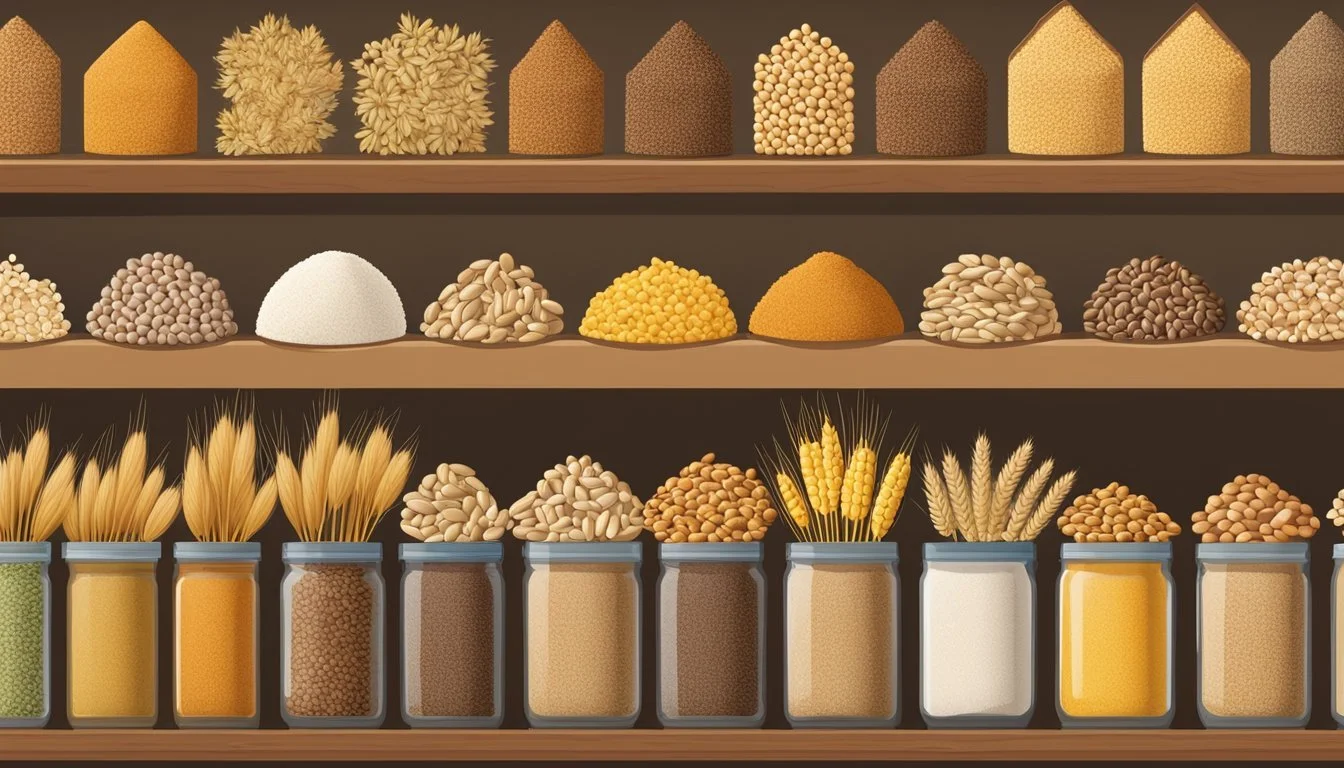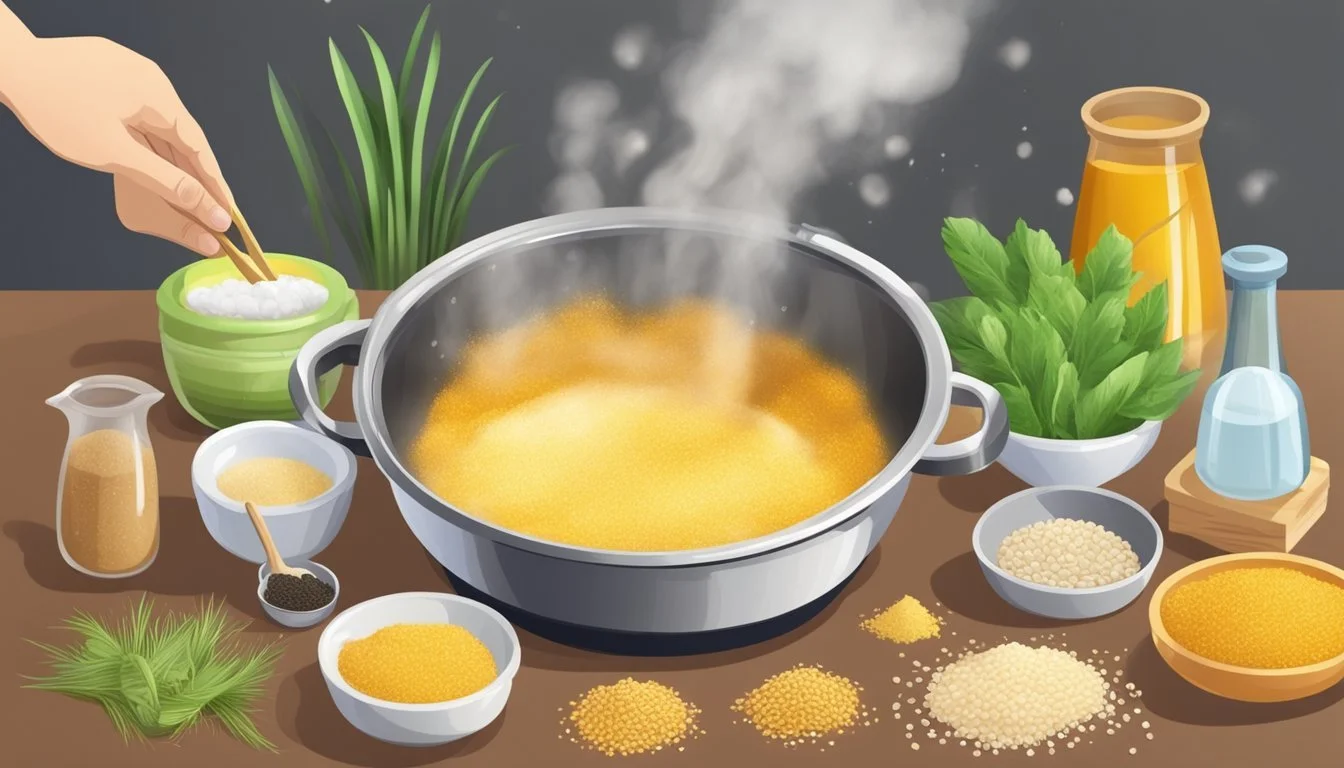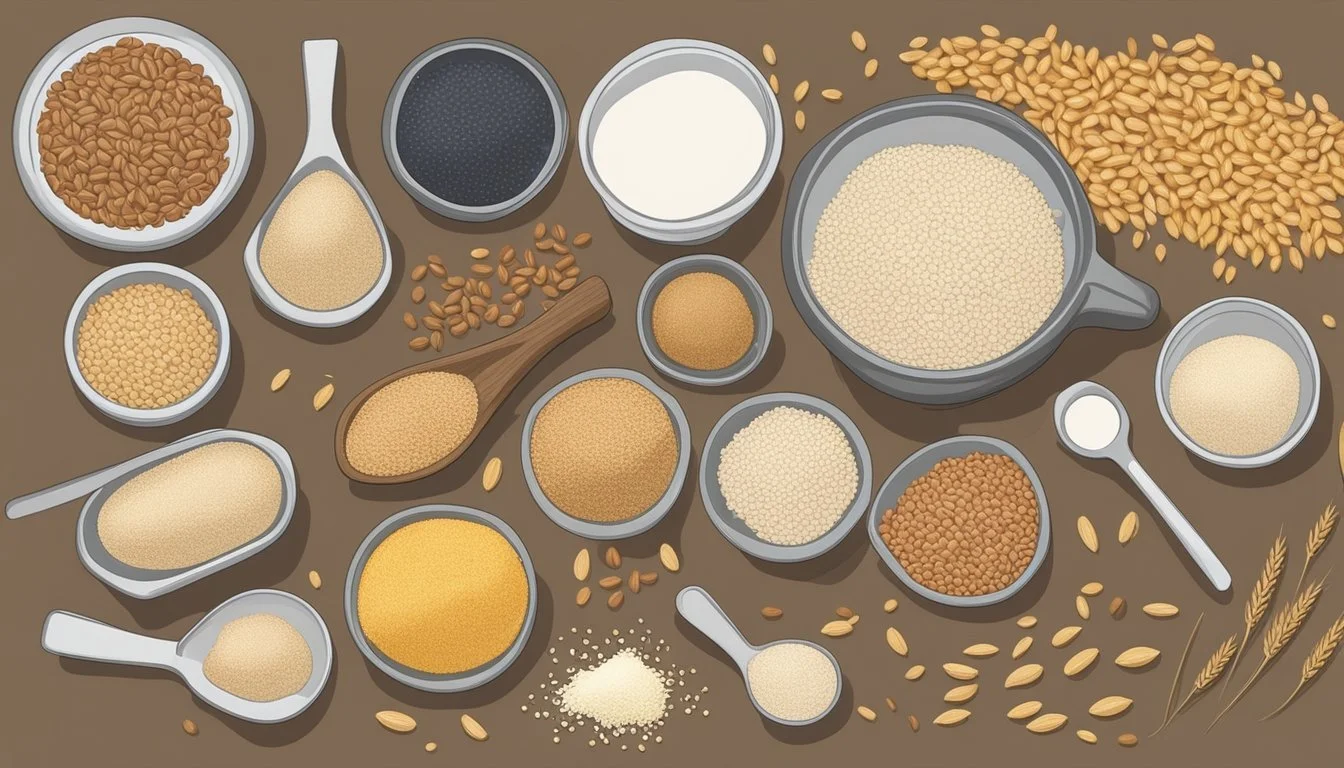Kamut Substitutes
Top Alternatives for this Ancient Grain
Kamut, an ancient grain with origins in Egypt, commands a loyal following due to its rich, nutty flavor and notable health benefits. Prized for its protein content, higher than that of common wheat, it also provides vital nutrients such as fiber, magnesium, and zinc, supporting everything from muscle repair to digestive health. Although this grain is versatile, those with wheat allergies or gluten sensitivities are often on the lookout for suitable substitutes that can maintain the culinary quality of their dishes without sacrificing nutrition.
Within the array of ancient grains available, emmer flour stands out as an excellent replacement for Kamut. Boasting a similar sweet and nutty profile, emmer flour, also known as farro, has been part of human diets for millennia and packs a comparable nutritional punch with abundant fiber and essential minerals. For those avoiding gluten, buckwheat emerges as a viable alternative, offering a distinctive earthy taste that can stand in for Kamut in various recipes. Buckwheat's gluten-free status, alongside its own set of healthful attributes like protein and mineral content, makes it an attractive option for a diverse range of dietary needs.
Understanding Kamut
Kamut, an ancient grain, is recognized for its rich nutrient content, including high levels of protein and fiber, as well as essential vitamins and minerals.
Historical Background
Kamut, also known as Khorasan wheat, is believed to have been cultivated as far back as Ancient Egypt. It was rediscovered in the 20th century and has since grown in popularity as a health food. Resilient by nature, Kamut thrives with organic farming practices, which preserves its nutrient-rich profile.
Nutritional Profile
Kamut's nutritional offerings are substantial, particularly regarding its protein content. A single serving provides a significant amount of this macronutrient, which is crucial for muscle repair and growth. Alongside protein, Kamut is lauded for its fiber content, aiding in digestive health.
Nutrients in Kamut include:
Protein: A high-quality source important for body repair and muscle growth.
Fiber: Beneficial for the digestive system and can help in maintaining a healthy weight.
Vitamins: Contains B-vitamins essential for energy metabolism.
Minerals:
Magnesium: Plays a role in over 300 enzymatic reactions, including muscle and nerve function.
Zinc: Critical for immune function and cellular metabolism.
Iron: Necessary for the production of hemoglobin, which carries oxygen in the blood.
Selenium: A powerful antioxidant that protects against cellular damage.
Moreover, Kamut boasts a low fat content and offers a bounty of complex carbohydrates, which provide long-lasting energy. Its contribution to health extends to its mineral content, with notable amounts of magnesium, zinc, iron, and selenium, all of which are essential for various bodily functions.
Culinary Attributes of Kamut
Kamut brings a distinctive nutty, buttery flavor, and its texture opens up a range of culinary uses, especially in baking. The grain's robust characteristics allow it to make a mark in recipes ranging from breads to pancakes.
Flavor Profile
The grain, Kamut, is known for its nutty and slightly buttery flavor, which makes it a desirable choice for a variety of dishes. This rich flavor allows it to stand out in a recipe, rather than just acting as a filler. Its taste is often appreciated in baked goods such as muffins and breads, where the grain's individual flavor can be a star ingredient.
Texture Considerations
When cooked, Kamut yields a firm, chewy texture, which is substantially denser than many other whole grains. This texture makes it ideal for recipes where a hearty feel is desired. In baking, it contributes to a consistent and satisfying bite, especially in items like dough-based foods. However, one must consider this texture to ensure it aligns with the desired outcome of the dish, as it might not be appropriate for recipes requiring a lighter, fluffier result.
Kamut in Dietary Contexts
Kamut, an ancient grain, finds its place within diverse dietary frameworks due to its significant protein and fiber content. However, it contains gluten, making it unsuitable for certain diet-specific concerns.
Gluten-Related Health Concerns
Kamut contains gluten, a type of protein that poses health issues for individuals with celiac disease or gluten sensitivities. For these individuals, consuming Kamut can lead to serious digestive and systemic symptoms. Buckwheat, despite its name suggesting otherwise, is naturally gluten-free and closely mirrors Kamut's nutty and earthy taste profile.
Vegan and Vegetarian Diets
Kamut is compatible with vegan and vegetarian diets as it is a plant-based source of nutrients. It is especially valued for its high protein content, which is crucial for muscle repair and growth in diets that exclude animal proteins. Additionally, its rich fiber content supports a healthy digestive system, aligning well with plant-based dietary principles.
Kamut for High-Protein and High-Fiber Diets
Those seeking diets with high-protein and high-fiber components may turn to Kamut for its nutrition profile. Its protein content contributes significantly to muscle maintenance and growth, while its fiber aids in digestion.
Protein: Essential for bodily repair and muscle building.
Fiber: Promotes healthy digestion and satiety.
Individuals who cannot consume Kamut but require similar nutritional benefits may consider emmer flour (farro flour) a suitable substitute, providing a comparable amount of protein and fiber.
Comparing Kamut to Other Grains
Kamut, also known as Khorasan wheat, is an ancient grain with distinct qualities. This section explores how it measures up nutritionally to other grains and the taste and textural differences that set it apart.
Nutritional Comparison
Ancient grains like Kamut, spelt, einkorn, and modern grains such as whole wheat flour and all-purpose flour each have unique nutritional profiles. Kamut typically offers higher protein content when compared to modern wheat. A cup of cooked Kamut contains about 9.8 grams of protein, which is more than both all-purpose and whole wheat flour.
Grain Protein Fiber Minerals Kamut High High Iron, Selenium, Magnesium, Zinc Spelt Moderate High Iron, Magnesium Einkorn Moderate High Iron Barley Low High Selenium, Magnesium Buckwheat Moderate High Magnesium, Manganese Modern Wheat Varied Varied Depends on processing Millet Moderate Moderate Magnesium
Compared to buckwheat and millet, Kamut shines in its mineral content, particularly in zinc and selenium, two minerals noted for their antioxidant properties.
Taste and Textural Differences
Ancient grains have flavors and textures that differ significantly from their modern counterparts. Kamut has a buttery and nutty taste with a firm texture that holds its shape well in salads and pilafs. In contrast, spelt, while also nutty, has a mildly sweet undertone and a somewhat soft texture.
Einkorn also falls under the ancient grains category and bears a rich flavor, which some describe as earthy with a lighter texture. On the other hand, modern wheat, used in all-purpose and whole wheat flours, is engineered for a less pronounced taste to increase its versatility in baking and cooking.
Grains like barley present a chewy consistency and a malty flavor, making them distinct from Kamut. Buckwheat, which is not a true wheat but rather a pseudocereal, offers an earthy and nutty taste and is naturally gluten-free, unlike Kamut and the other mentioned wheats. Millet provides a mildly sweet flavor and a light texture, often used in porridges and as a couscous alternative.
In comparison to ancient wheats, modern wheat varies in taste, and texture is often processed into all-purpose flour which is designed for lightness and a neutral flavor to maximize its applications in a variety of recipes.
Substitutes for Kamut
Finding the right substitute for Kamut involves balancing taste, texture, and nutritional content. Consumers may seek alternatives for various reasons including gluten intolerance or simply to achieve a different flavor or nutritional profile in their recipes.
Gluten-Free Alternatives
Buckwheat: Buckwheat is a gluten-free grain that is often recommended for those who cannot consume Kamut due to dietary restrictions. Not only does it offer a comparable nutty and earthy taste, but it also provides essential nutrients.
Nutrient Benefit Fiber Supports digestive health Protein Contributes to muscle repair and growth Magnesium Facilitates various bodily functions Manganese Plays a role in bone formation and energy metabolism
Amaranth and Quinoa: Both amaranth and quinoa are nutritious, gluten-free alternatives to Kamut. They provide a wealth of vitamins and minerals, and their protein content includes all nine essential amino acids, making them complete protein sources.
Similar Ancient Grains
Spelt Flour: Spelt is a whole grain that is often used as a substitute for Kamut due to its slightly nutty flavor profile and versatility in baking.
Nutrient Description Protein Essential for building and repairing tissues Fiber Aids in digestive health Vitamins B vitamins for energy metabolism
Einkorn Flour and Farro: Einkorn and farro (also known as emmer) are ancient grains with rich histories. They serve as good substitutes for Kamut, offering a similar taste and an array of nutrients that benefit overall health.
Nutritionally Comparable Substitutes
Freekeh: Freekeh, a whole grain prepared from young green wheat, comes close to Kamut concerning its high fiber and protein content. It makes for a very nutritious alternative, assisting in maintaining blood sugar levels and promoting satiety.
Rice: When looking for a substitute that is easy to find and cook, rice is the go-to grain. Brown rice in particular is nutritionally superior to white rice, as it retains the bran and germ, offering more fiber and nutrients.
Preparing and Cooking Substitutes
When substituting Kamut in a recipe, understanding the specific preparation techniques and appropriate baking alternatives is vital for maintaining both texture and flavor.
Cooking Techniques
For whole grain substitutions, they typically suggest soaking grains such as spelt or amaranth overnight to reduce cooking time. When ready to cook, it is essential to follow a standard ratio of 1:3, which translates to one part grain to three parts water, achieving a tender texture. This applies when cooking spelt, a popular substitute, which resembles Kamut's nutty flavor.
Example Cooking Process for Spelt:
Soak spelt grains overnight.
Drain and rinse the grains.
Add grains to a pot with fresh water using a 1:3 grain-to-water ratio.
Bring to a boil, then reduce heat and simmer until tender.
Flour Substitutes in Baking
When replacing Kamut flour in baking, choosing the right flour substitute is crucial to match texture and flavor. Spelt flour is a preferred alternative, offering a similar nutritional profile and a slight nuttiness that complements most baked goods. Amaranth flour and almond flour are also viable options; with amaranth flour being ideal for adding a malty sweetness and almond flour offering a moist texture and rich flavor.
Bakers should use a 1:1 ratio when substituting spelt or whole-wheat flour for Kamut flour to maintain the structure of the baked goods. When using alternative flours like amaranth or almond, adjustments may be necessary due to differences in protein content and absorption qualities.
Kamut Flour Substitute Flour Ratio Notes 1 cup Spelt Flour 1:1 Maintains similar density and texture. 1 cup Whole-Wheat Flour 1:1 Provides a hearty structure. 1 cup Amaranth Flour Varies May require more liquid; lends a slight maltiness. 1 cup Almond Flour Varies Adds moisture; requires less oil or butter.
In summary, they carefully consider alternatives both for whole grains and flours, ensuring a proper match for Kamut's unique qualities in recipes.
Practical Tips and Considerations
When incorporating substitutes for Kamut in recipes, precision in substitution ratios and attention to preserving desired flavor and texture profiles are crucial.
Calculating Substitution Ratios
In most cases, replacing Kamut with another grain can be done using a 1:1 ratio, especially when using closely related grains such as spelt or whole wheat flour. That means if a recipe calls for one cup of Kamut flour, one can typically use one cup of the substitute flour. However, for grains with significantly different absorbency or bulk density, this may need adjustment. The actual ratio can be influenced by the substitute's protein content and its capacity to retain moisture.
Spelt Flour: Use a 1:1 substitution ratio.
Whole Wheat Flour: Also generally a 1:1 substitution ratio.
Buckwheat: May require adjustments for gluten-free recipes. Start with a 1:1 ratio, then adjust if necessary.
Adjusting Recipes for Flavor and Texture
Kamut is known for its rich, nutty flavor and chewy texture which contributes depth to baked goods. Substitutes should aim to mimic or complement these sensory attributes:
All-Purpose Flour: It's more neutral in taste and may affect the nutritional profile, so it can be enriched with whole grain flours.
Buckwheat: Offers an earthy, nutty taste good for gluten-free options. It may alter the texture slightly, making baked goods denser or heavier.
It is also important to recognize that the change in grain may affect the moisture levels in recipes, as different flours absorb water differently. When substituting, one should start with the prescribed amount and adjust the liquid ingredients as necessary to achieve a similar consistency to the original recipe with Kamut.
Health and Environmental Impact
When considering substitutes for Kamut, the health benefits and the environmental sustainability of alternative ancient grains are paramount. The right substitutes should contribute not only to the individual's health, for example by aiding in digestive health and muscle repair, but also support sustainable agricultural practices.
Sustainable Farming Practices
Substitutes for Kamut such as Einkorn, Freekeh, and Spelt often adhere to sustainable farming methods that underscore organic agriculture. Organic farming of these grains typically means farming without synthetic pesticides and fertilizers, thereby reducing environmental strain. Ancient grains are often prized for their ability to thrive in poor soil conditions with less water, making them a resilient choice for eco-conscious consumers.
Kamut's Health Contributions
Kamut is noted for its contributions to health, with a high protein content essential for muscle repair and a substantial amount of fiber promoting digestive health. Moreover, Kamut is rich in nutrients such as magnesium and zinc which are crucial for metabolic processes and immune support. Alternatives to Kamut should ideally maintain this profile, offering a rich flavor while potentially preventing chronic diseases related to nutrient deficiencies.
Frequently Asked Questions
What are some common substitutes for Kamut? For those looking to replace Kamut in recipes, a variety of grains may be used:
Buckwheat: Gluten-free, with a nutty and earthy flavor.
Emmer Flour (Farro Flour): Nutty, slightly sweet, rich in fiber and protein.
Spelt: Similar in taste, though different in texture and nutritional content.
Is there a gluten-free option for Kamut? Yes, Buckwheat is a gluten-free grain that can substitute for Kamut and is beneficial for those with gluten sensitivities or celiac disease.
How does the nutritional profile of Kamut substitutes compare?
Buckwheat: High in fiber, protein, and minerals such as magnesium and manganese.
Emmer Flour: Offers comparable levels of fiber and protein, with essential minerals like iron and magnesium.
Spelt vs Kamut: Spelt has around 5.5 grams of protein and 4 grams of fiber per 100g serving, whereas Kamut offers about 7 grams of protein and 7 grams of dietary fiber for the same amount.
Can I use these substitutes in baking? Yes, these grains can be used in baking. They may alter the texture and flavor slightly, so adjustments in liquid or leavening agents might be necessary.

